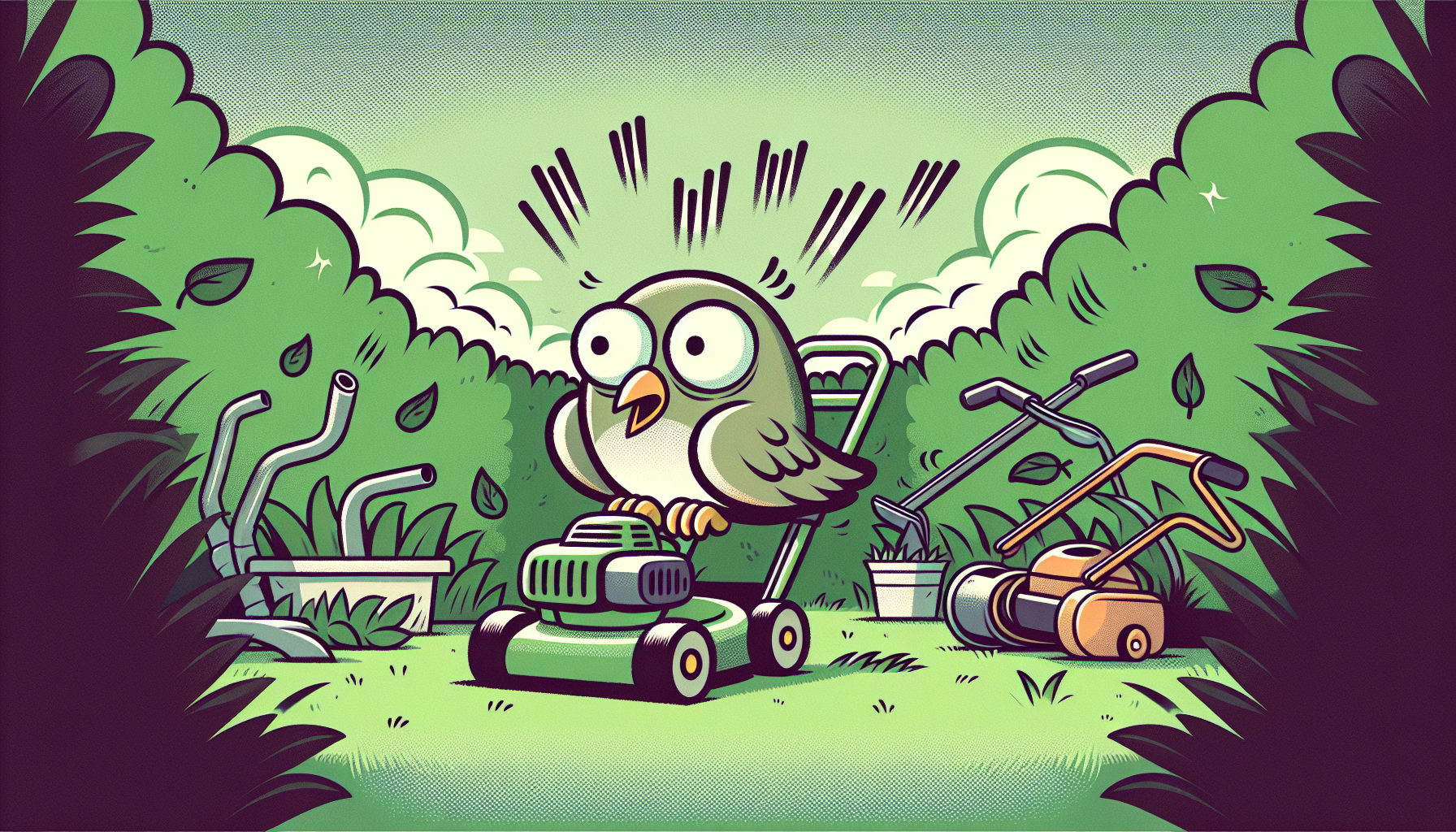
Noise in the garden: how to protect birds from acoustic pollution
Noise is part of everyday life in cities and increasingly also in villages. For birds, however, noise in the garden is more than just a nuisance, as it alters communication, breeding, foraging and flight behavior. This guide shows how anthropogenic noise masks acoustic signals, why certain times are particularly sensitive and what measures in the garden can help immediately. You will learn how to recognize and muffle noise sources and at the same time observe birds with quiet technology - without causing them additional stress. Specific tips on power supply, WLAN and camera locations make implementation easier. The article also clarifies the most important legal points so that your observation remains compliant with data protection regulations and species protection is ensured. In this way, you can create a garden that is close to nature, offers safe retreats despite the noise in the garden and provides birds with food and breeding grounds.
Effects of noise in the garden on birds

Noise in the garden not only disturbs birds subjectively, but also masks their signals. Acoustic masking occurs when traffic or noise levels drown out calls, warning sounds and songs or are in the same frequency ranges. This costs energy, reduces the chances of reproduction and changes territorial boundaries.
Many species adapt their voices, for example by increasing their volume or changing their pitch. This compensation does not work equally well for all species and is physiologically stressful. Sensitive species move away or give up breeding sites.
Typical consequences quickly become apparent in everyday garden life. Mating partners are harder to find, warning calls are delayed and young birds are less successful at begging. The perception of enemies also suffers, making it easier for cats or birds of prey to attack.
Even moderate continuous sound shifts activity patterns. Blackbirds start singing earlier in order to take advantage of quieter time windows, while shy species remain silent for longer periods. This results in fewer territorial songs, lower mating rates and gaps in the species inventory.
Feeding areas in noisy surroundings are visited less frequently. Birds reduce the amount of time they stay, peck hastily and stop foraging as soon as new sound peaks occur. This is particularly true for robins, wrens and other cautious species.
Young birds are also affected. Covered begging calls lead to less frequent feeding, which weakens growth and thermoregulation. In combination with weather stress, losses increase during the nestling phase.
In practice, a clear priority helps: avoid noise in the garden, separate sources of noise and create quiet zones. Natural structures, scheduled work and quiet technology immediately reduce masking and stress.
Nesting behavior and communication
During courtship and breeding, mates coordinate feeding, guarding and relieving each other by calling. If this is drowned out by noise in the garden, feeding frequencies fall and the risk of nest abandonment increases. Higher call frequencies only partially compensate and cost additional energy.
Foraging and enemy avoidance
Birds rely on sight and hearing to find food and detect enemies. Continuous noise makes birds cautious, shortens their search for food and increases wrong decisions. A quiet feeding area with visual protection significantly improves safety and approach readiness.
Sensitive times: Breeding season and winter
The effect of noise in the garden varies seasonally. The breeding season and winter are particularly sensitive because energy levels, finding mates and caring for young are at their limit. Minor disturbances then have a disproportionately large effect.
In spring, courtship song, territory demarcation and nest building must function reliably. Overlapping singing makes mate selection more difficult and results in fewer pairs. Regular noise peaks such as leaf blowers or construction sites are also stressful.
Breeding season: March to end of summer
Most garden birds breed between March and July; some late broods breed until August. Noise in the garden close to the nest increases absences of adult birds and weakens chicks. Plan noisy work early in the day for a short time only or postpone it to quieter weeks.
Avoid mowing and pruning work in the immediate vicinity of the nest. If you tolerate hedges as a nesting site, use days with low traffic or construction site noise. A quiet buffer of 10 to 20 meters around known nests works wonders.
Winter feeding and peace and quiet
Every calorie counts in winter, but noisy locations are avoided. Place feeders away from wind and noise, with a clear view of approach paths. A fixed rhythm and brief disturbances noticeably improve the acceptance of shy species.
Use weather-protected silos instead of open trays to reduce diseases. Ambrosia-free quality feed and alternating positions reduce contamination. NABU offers additional tips on feeding birds in winter at nabu.de.
The following also applies in the cold season: keep noise in the garden to a minimum. Avoid continuously running, loud pumps near the feeding area and reduce unnecessary noise during the refilling routine. This will keep the time spent in the garden longer and the energy account positive.
Recognize and minimize sources of noise
Effectiveness starts with an inventory. List typical sources of noise, measure distances to feeding areas and nesting boxes and observe the birds' reactions. Only then can you prioritize measures against noise in the garden.
Typical sources of noise in the garden
- Power tools such as lawn mowers, leaf blowers, hedge trimmers and chainsaws
- Pond pumps, fountains or filters with an audible hum
- Loudspeakers, radios and loud conversations on terraces
- Construction and renovation work near the property
- Play areas directly next to hedges with possible nests
Even low continuous noise levels add up when sources overlap in time. Spread out noisy activities and create quiet areas where no appliances are running. The greater the distance and the more vegetation in between, the less masking there will be.
Strategies for noise reduction
- Switch to quiet alternatives such as hand mowers or modern battery-powered devices
- Choose time windows with little outside noise for unavoidable work
- Use dense hedges, shrub islands and bushes as natural noise absorbers
- Deliberately move feeding stations and nesting boxes to the quieter side of the garden
- Decouple permanent sources, reduce vibrations or make them quieter
A hedge mix of privet, hazel, elder and native wild roses absorbs noise and provides cover and food. Combine this planting with privacy screens or light earth walls to further break up noise in the garden.
Document bird activity before and after measures. More time spent at the feeder, more frequent singing and fewer flight reactions show that your damping measures are working. Smaller adjustments to the location often have the greatest effect.
Technique for bird observation without disturbance
Quiet, smart technology enables observation without increasing noise in the garden. The aim is a stable system consisting of a camera, power supply and Wi-Fi that works reliably and remains virtually invisible to birds.
Camera selection and functions
- WLAN bird cameras for nest boxes with infrared night vision and low-flicker LEDs
- Motion-activated wildlife cameras with virtually silent triggering
- IP cameras with zoom and app access for remote monitoring
Look out for quiet autofocus, dimmed infrared lights and robust housings with UV and weather protection. High frame rate and sufficient resolution facilitate species identification and documentation. Camouflage colors and matt surfaces reduce reflections and conspicuousness.
WLAN, power and location
Solar modules with batteries reliably supply remote locations if the orientation and shade are right. An outdoor WLAN repeater brings the network to the feeding site or nesting box without additional cable runs. Avoid buzzing noises from the device and decouple mounts to prevent vibrations.
Install cameras slightly elevated with a clear view and lateral angle. This keeps approach routes clear and birds feel less observed. Only point cameras at your own property to ensure privacy and avoid increasing noise in the garden due to frequent user access.
Plan data storage, app notifications and power reserves. Fewer push alerts mean less interaction and therefore less activity in the garden. A clear maintenance schedule prevents unplanned visits on sensitive days.
Law, common mistakes and practical solutions
Species protection and data protection create clear guidelines for technology and maintenance. Those who know the rules protect birds better and avoid conflicts. At the same time, a structured approach helps to permanently reduce noise in the garden.
Legal basis
§ Section 39 of the Federal Nature Conservation Act (BNatSchG) prohibits heavy pruning of hedges from March 1 to September 30 in order to protect breeding birds. Details can be found in the legal text at laws-on-the-internet.com. In addition, § 44 BNatSchG protects breeding and resting sites of particularly protected species regardless of the month; the text can be found at laws-on-the-internet.com.
Cameras may only record your own property. Ensure clear orientation, short storage periods and secure passwords. The Federal Environment Agency provides information on noise and precautions at umweltbundesamt.de.
Common mistakes and better alternatives
- Camera installed too close to the nest: Increase the distance and mount to the side
- Open feeding bowls in noisy locations: place weather-protected silos in quieter locations
- Continuous operation of humming technology: decouple, muffle or replace quietly
- Working at inopportune times: move noisy activities to quieter phases
- Cables without protection: use floor cable ducts or protective conduits
Start with a map of your garden and mark sources of noise, escape routes and cover. Gradually move feeders and nesting boxes to quieter areas, test locations and record visits. This reduces stress and noise in the garden loses its effect.
Conclude with a simple weekly plan: a quiet maintenance day, a check on the camera and feeder, otherwise peace and quiet. Small routines bring continuity, increase the length of time the birds stay and make observations predictable. Get started now - observe birds with technology, but without disturbance!
